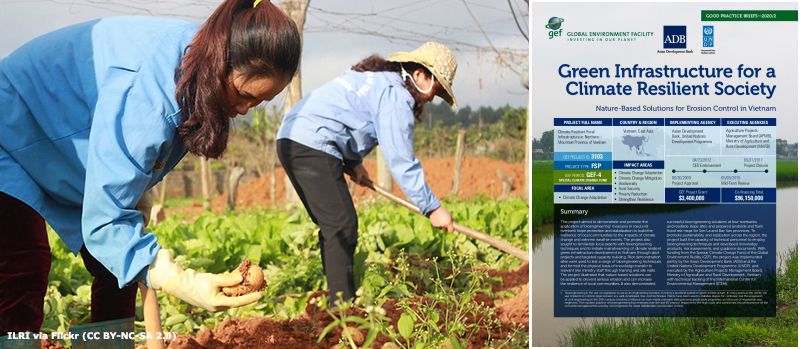
Climate Resilient Rural Infrastructure Project in Northern Viet Nam Successfully Promotes Application of Bioengineering Techniques
Viet Nam is a hazard-prone country. Its 3,260-kilometer coastline is regularly exposed to typhoons, floods, drought, coastal erosion, and landslides. This poses significant threats to roads, embankments, and water supply infrastructure. An estimated 97% of average annual economic losses from natural hazards is caused by flooding.
Viet Nam’s northern provinces are highly vulnerable to climate-related challenges that negatively impact local communities. The ability to maintain and rehabilitate limited and infrastructure that is necessarily built under constrained budgets is difficult. The resilience of rural infrastructure to climate related stresses is an increasing challenge and of high importance to the rural communities.
Climate Resilient Rural Infrastructure in Northern Mountain Province of Viet Nam
The Climate Resilient Rural Infrastructure in Northern Mountain Province of Viet Nam project demonstrated and promoted the application of bioengineering measures in road and riverbank slope protection and stabilization. It familiarized local experts with bioengineering techniques, and initiated mainstreaming of climate resilient green infrastructure development in Viet Nam through demonstrations and targeted capacity building.
Approved in June 2009, the project was funded by the Special Climate Change Fund of the Global Environment Facility (GEF), and implemented jointly by the Asian Development Bank and the United Nations Development Programme, and executed by the Agriculture Projects Management Board, Ministry of Agriculture and Rural Development, Viet Nam, with technical backing of the International Centre for Environmental Management.
The project was officially closed in May 2017. GEF published a Good Practice Brief about the project. Shared at the 57th Council meeting of GEF, the Brief identifies good practice examples, in line with key GEF2020 strategic priorities and GEF-7 programming directions and policy recommendations.
Bioengineering measures in road and riverbank slope protection and stabilization
Bioengineering measures, such as erosion control, water conservation, enhanced slope stability, and sustainability of water-crossing structures, provide the opportunity to realize many benefits, including
- low-cost options to supplement conventional infrastructure engineering designs;
- strengthening the resilience of infrastructure, especially in rural areas where infrastructure standards are lower making the infrastructure more vulnerable to extreme weather events;
- reducing maintenance and rehabilitation costs. Bioengineering methods actually add strength with time as the plants take firm root; and
- increasing social, economic, and ecosystem gains, through local resource methods that use local cost-effective labor, materials and knowledge.
When applied at a larger scale, such as riverbank protection at watershed level, traditional “hard” engineering methods such as reinforced concrete are unaffordable over a wide area.
By protecting soils from erosion and reducing storm surges, bioengineering measures can significantly impact climate change mitigation and adaptation, biodiversity conservation and food security.
This project in the Northern Mountain Province of Viet Nam, prioritized inclusivity for the community by employing a high proportion of women and a wide range of ethnic minorities. Their local knowledge of plants and ecosystems should be used to provide valuable input to the design of the works.
Results and lessons learned
The project ably provided bioengineering solutions at four riverbanks and roadside slope sites, landslide and flash flood risk maps for Son La and Bac Kan provinces, and capacity building for technical personnel in employing bioengineering techniques. It also developed knowledge products, risk assessments, and guidance documents. Bioengineering training was embedded into local University engineering courses.
This project demonstrates that application of nature-based solutions can help prevent serious erosion and strengthen resilience of local communities. Its success underscores the need for on-going investment in scaling up and mainstreaming bioengineering in infrastructure and the key role development partners play in promoting nature-based solutions.
The Good Practice Brief presents a comprehensive discussion of project innovation, outcomes, and lessons learned.
